[This story originally appeared in Alpinist 81, which is available in our online store.–Ed.]
IN THE DARK HUSH of a stone hut in upper Hunza, a young woman and her two older brothers rose early to climb 6034-meter Minglik Sar, the snow-draped peak that rises above Shimshal Lake. On that day in late May 2006, ice veiled the blue waters of the lake and deep snow cloaked the higher reaches of the mountains. Farzana Jabeen and her brothers, Rahmat Ullah Baig and Aziz Khan (both experienced climbers and expedition workers), had left their village of Shimshal two days earlier, moving their family’s goats and sheep to traditional summer grazing pastures as they walked.
A few clouds dappled the blue sky as they traveled up the rocky terrain. At 5200 meters, they roped together for the final push to the top through the thick spring snow. At the summit, tears of joy stained Jabeen’s cheeks. Until that day in 2006, no Pakistani woman had recorded an ascent of such a high mountain. Now Jabeen thanked Allah for fulfilling her long-held dream to climb, then embraced her brothers. She gazed in awe at the giants of the Karakoram before her and saw, for the first time, the magnificent triangular monolith of K2, its glistening slopes of ice and bare rocks looming above the other mountains.
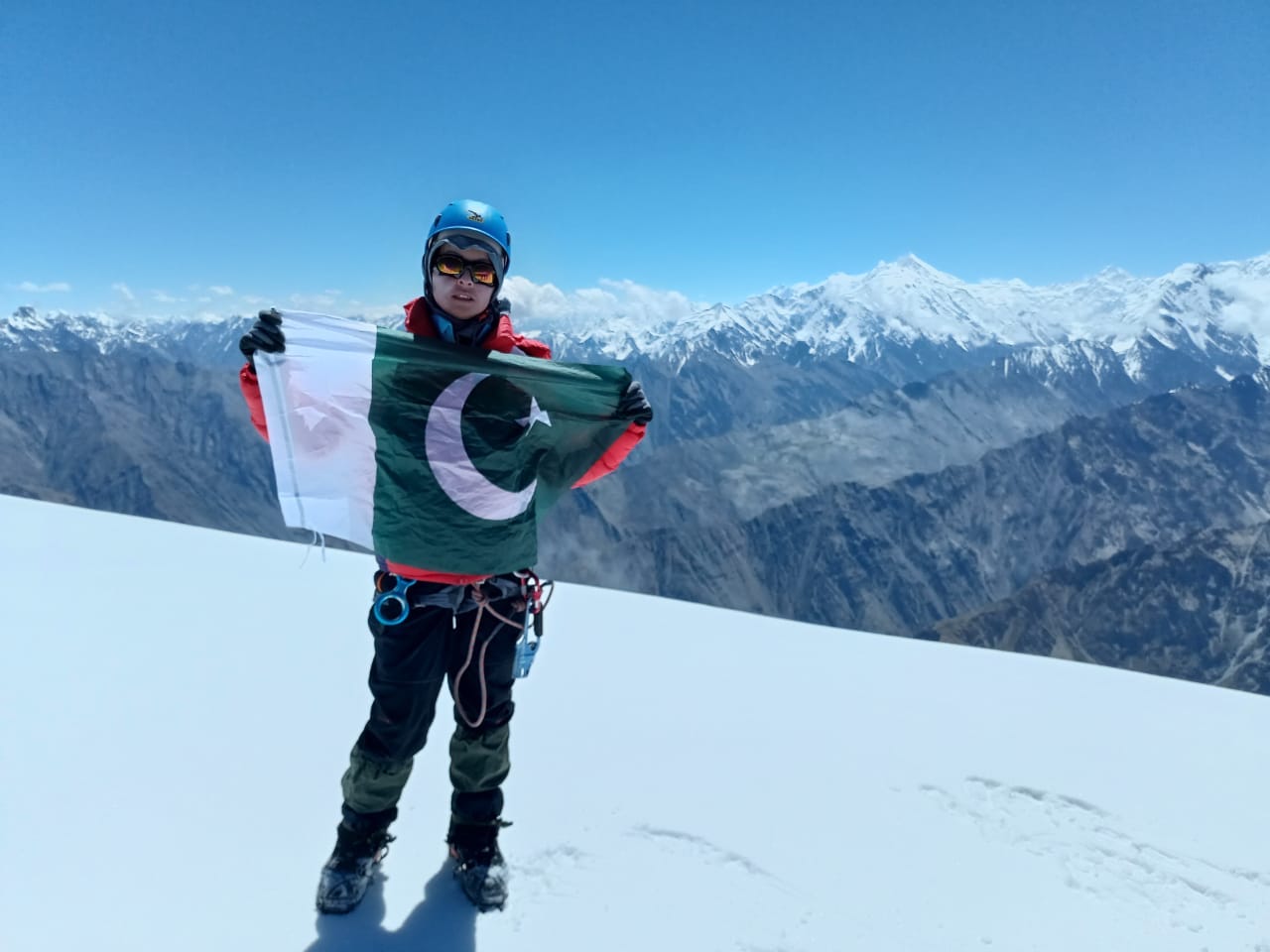
BEFORE I SET OUT to write about Pakistani women climbers, I had never heard of Jabeen. The news of her successful climb received scant attention at the time. I found only two Urdu newspaper accounts dated to 2006. I could not reach Jabeen because she lives in Shimshal village, where cell service is not reliable. Her older brother Baig, a climber and a high-altitude guide, recently shared her story with me. She regrets the lack of recognition for her success, her brother said.
The first women climbers of Pakistan are trailblazers. Their entry into a male-dominated domain defies the traditional and religious restrictions of a conservative culture where women are even discouraged from riding a bicycle. I read about Pakistani male climbers but saw little about women, except for Samina Baig, who in 2013 became the first Pakistani woman to reach the top of Everest. However, on visits to Gilgit-Baltistan in 2018 and 2019, friends told me of more Pakistani women, from the north and other parts of the country, climbing high peaks. I wondered why I never saw any press accounts about their achievements in international media, and I wanted to write about them.
In my own childhood in Karachi, I learned about mountains from my mother’s story about Koh-e-Qaf, a mythical snow-clad peak where fairies and giants lived. We lived close to the sea and I saw only hills, barren and dry. I wanted to scamper up those hills and see what lay beyond, but I knew the place of girls was in the home, not outdoors. Like most Pakistani women, I also heard the four dreaded words: “Log kya kahain gay?” (What will people say?). Families use these words to thwart women who dare to do something not sanctioned by society–higher education, working, delaying marriage, outdoor sports.
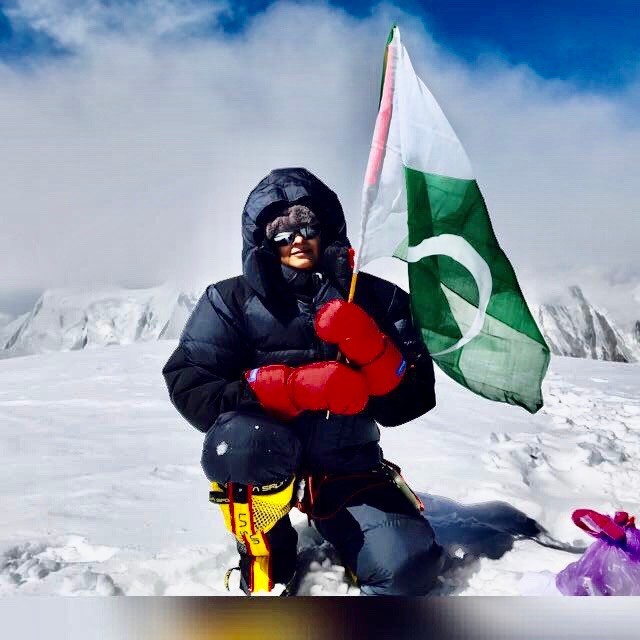
In 1968 I left for college in South Dakota and got my first sight of real peaks when I visited a friend in Wyoming during the winter break. From the high plateau of Laramie, I saw mountains rising in the distance, some clad in snow, some with sharp angles and bare flanks. Mountains became part of my life in the late 1970s when I moved to Alaska. From my house in Anchorage, I look upon the Kenai and Aleutian ranges and Redoubt Volcano, and I hike on trails in the Chugach Mountains on the east side of the city. Finally, on a 1988 journey to Kashgar, I saw the Karakoram Range for the first time. The peaks were jagged grey-and-white points that pierced the sky.
In the early ’80s I became aware of Pakistani men from northern areas climbing as support staff with foreign expeditions that sometimes included women. Seeing the names of women from other countries gave me hope that someday a Pakistani woman might also stand atop a mountain.
In the early 2010s, climbing by Pakistani women gained momentum, and news of their successes began appearing in Pakistani media. Samina Baig, also from Shimshal, became renowned for her climbs and was lionized in the press. In 2010 Baig became the first woman to climb the ca. 6000-meter Chaskin III in the Chaskin group. Chaskin Sar is visible from Shimshal Pass, where Baig and her mother used to take their yaks, sheep and goats to graze. She’d loved the serac-draped peak since childhood, she recently told me. When Baig reached the top of Everest in 2013, her achievement received widespread praise, and I wondered whether it would spur other women to climb. A photo taken at the summit shows Baig smiling as she holds a small Pakistani flag under a vivid cobalt sky, puffs of clouds billowing below and the Himalaya spilling away to the horizon.
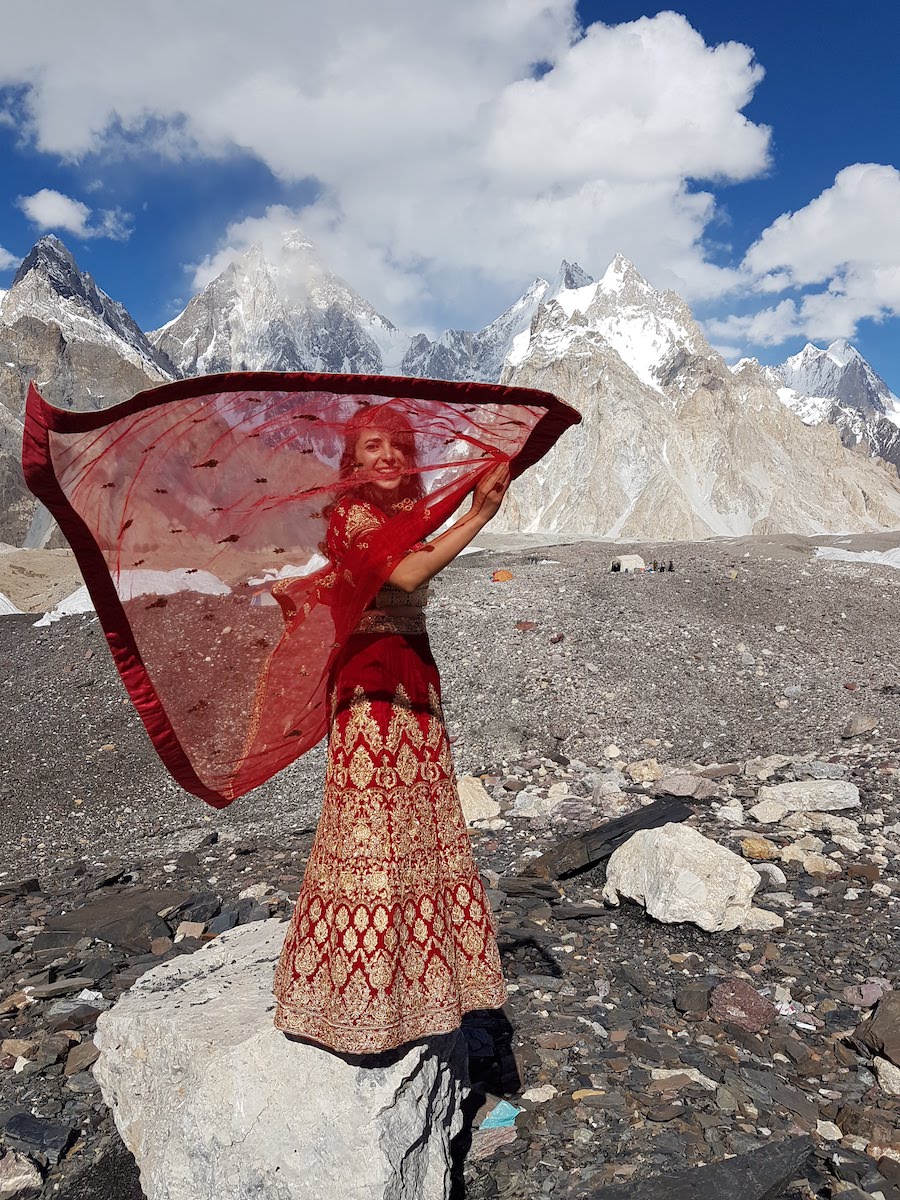
IT IS FITTING THAT the history of Pakistani women climbers should begin amid the tall peaks of northern Pakistan. Though today several mountain guides come from many parts of Gilgit-Baltistan, including Skardu, Nagar, Gilgit and Hunza, the area of Shimshal is known as the valley of mountaineers. For centuries, Shimshalis had lived in relative isolation, surrounded by high peaks, alpine passes and glaciers, and their way of life helped prepare them for the rigors of climbing. They had become used to trekking at altitude as they herded animals to high pastures. In winter, snow cut them off from the outside world. In summer, they had to spend several days hiking along a dirt path to reach the closest highway. That journey now takes four hours of driving on the rough, single-lane road (completed in 2003) that twists above the Shimshal River, hemmed in by a deep gorge on one side and cliffs on the other.
Most people in Hunza, including Shimshalis, follow Ismailism, a subsect of Shia Islam. Pakistani Ismailis have a high literacy rate, and they value education for both boys and girls. Women like Jabeen and Baig became interested in climbing from hearing stories from men in their families and communities who climbed for pleasure or worked as expedition workers and guides. After Everest, Baig completed the Seven Summits and was appointed Pakistan’s National Goodwill Ambassador by the United Nations Development Program. As Pakistan’s first famous professional woman mountaineer, Baig began using her platform to advocate for gender equality. “I reached my goals of becoming a mountaineer because my family and community supported me,” she recounted on a call. Baig now works with Pakistan Youth Outreach, her brother Mirza Ali’s organization, to teach young men and women about rock and ice climbing.
One young woman from Shimshal, Shama Baqir, started participating in the Pakistan Youth Outreach workshops in 2019. I heard about Baqir from the Alpine Club of Pakistan and connected with her through WhatsApp. Baqir’s love for mountains began early, she told me. “I began clambering up nearby hills as a child,” she said, “but always wanted to go higher like the men in the village who went on expeditions.”
In 2021 mountaineer and climbing instructor Abdul Joshi invited Baqir and another woman, Sultana Nasab, to join an all-Shimshali team for an attempt on an unclimbed 6076-meter tower of the Passu Cones in the Karakoram Range. “The first part, a long uphill climb over loose rock, was easy,” Baqir said. “But problems came on the rocky cliffs, snow and ice higher up.” Above their base camp, the team fixed a total of 2500 meters of rope to the sharp-angled summit. On the last day of the climb, the mountaineers lumbered through deep drifts of snow. “[I] pushed away my fear even as my stomach tied up in knots,” Baqir told me. Eventually they came to a steep wall of ice. “The climbers ahead began to chip the ice and shards rained down,” she said.
Joshi was the first to reach the summit–a small pyramid of rock with sharp sides jutting from the snow. Its surface offered no standing room, so Joshi straddled it, holding a Pakistani flag aloft. It was August 13, the day before Pakistan’s Independence Day. One by one, each team member stood on the top, then later gathered on a lower ledge for a group photo with more flags. After the climb, Baqir said, “I felt extremely happy. In Pakistan people say women are weak and can’t achieve much. But after the climb I realized all women can do what any male can do with a positive attitude, passion and potential.”
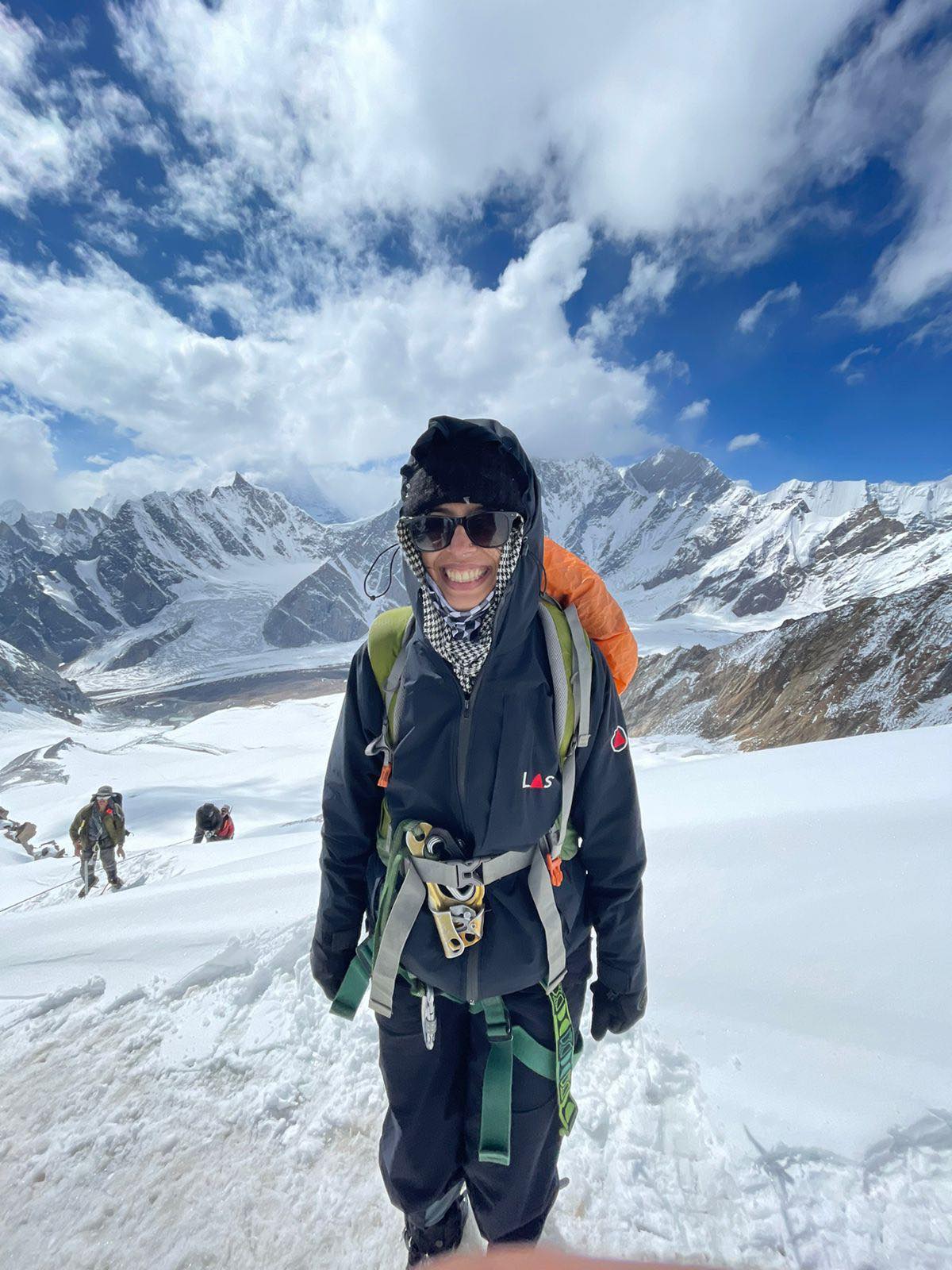
WHILE INITIALLY MOST WOMEN climbers of Pakistan came from the north, in recent years more women from urban areas have joined in. I also heard about Uzma Yousaf from the Alpine Club of Pakistan, and I reached her through Facebook Messenger. Yousaf was raised in Peshawar and now lives in Islamabad. Her 2016 ascent of the 6034-meter Minglik Sar in Shimshal was likely the first by an urban Pakistani woman. Yousaf’s fascination with mountains came from documentaries she watched as a child of people climbing mountains and exploring rain forests. She longed to wander the tawny, dusty foothills of the Safed Koh Range around Peshawar. But her parents only allowed her out of the home to go to school. “Our house had high walls and a large gate. It felt like a prison. They told me constantly not to speak loudly and to drape my dupatta [scarf] on my head,” she said.
Her confinement continued even after she married a man who owned a touring company. “Before marriage, my life rotated between home and school, and after marriage, home and family,” she said. But by 2015 her sons were older, and Yousaf’s husband let her come along on his company’s trip to Nanga Parbat base camp.
In October 2016, she joined a Pakistani group of eight men and one woman to climb Minglik Sar. The other woman quit early on, but Yousaf continued. Some of the men made malicious comments. “One of them told me my place was at home taking care of family. Another asked if my husband let me come because he wanted to get rid of me. I ignored the barbs,” she said. On their summit day, snow fell steadily, becoming heavier higher up. “We could not see ahead very well, and the rest of the group turned back,” she said.
Yousaf, determined to summit, continued. Roped with the two guides, she made it to the top. She stood for a few minutes in silence. Snow fell around her. Cold seeped into her bones. “I had succeeded,” she said. “I knew then I could go higher.”
In February 2017 she set out to climb the 5098-meter Rush Peak in Hunza. Once again on a snowy day she trudged across the frozen, high-altitude Rush Lake with her team. Overnight, the temperature plunged to -28?C, according to Yousaf. “It was the coldest night of my life.” She climbed the mountain after a fitful sleep.
Now Yousaf felt ready for another, more ambitious climb. In July 2017, she set out for Spantik, a 7027-meter peak that had long intrigued her. “I loved looking at Spantik on my trips to Hunza–especially its angular facade glowing gold at sunset,” she recounted. Three local high-altitude guides accompanied her. Several days of hiking brought them to their base camp at 4300 meters, where Yousaf picked wildflowers for bouquets. After the team finished rotations up to Camp III, the weather deteriorated. Yousaf waited a week at base camp before continuing up the mountain.
On the day of their summit push, the team set out under clouds. They stopped at Camp IV, where they left most of their heavy gear. The team had planned to summit, pick up their equipment and return to base camp on the same day. The weather worsened as they went up. At the top, Yousaf saw nothing but snow swirling around her. The wind blew stronger during the descent, and the team could not pick out the route, she said. Yousaf had felt elated about her success, but now she worried about her team’s safety. In the fading daylight she wondered if they would make it.
The hour for evening prayers arrived and Yousaf prayed. “As if by a miracle, the clouds parted for the setting sun and its rays lit up everything,” she said. “We found the route.” They reached their tent at Camp IV and crammed inside to spend a restless night without food or water. The next day, they made it back to base camp. Her successful climb on Spantik had made her the first Pakistani woman on that mountain.
Yousaf attempted 8051-meter Broad Peak in 2018 and 2019 but stopped because she felt she had inadequate training. She has not climbed since and is now busy studying painting and sculpture, doing fitness training and caring for her family. She cherishes the time spent on mountains and what she learned from her climbs. “My experience on the mountains taught me how to be strong, to stay focused and to not lose hope,” she said.
NAILA KIANI, NOW CONSIDERED one of Pakistan’s foremost women climbers, first saw the high mountains of Pakistan only in 2018. Growing up in Rawalpindi, she wanted to explore the low, green Margalla Hills to the north, but her parents kept her away from sports or outdoor activities. “I saw TV shows and photos of mountains in Pakistan’s north in my childhood and wanted to see K2, but my home life and later school and work made that impossible,” she told me.
She convinced her parents to let her study aerospace engineering in London, where, freed of family constraints, she joined a gym, began running and trained as a boxer. After her studies, she moved to work in Dubai and became a banker. When she married in 2018, she and her husband decided to trek to K2 base camp instead of holding an elaborate wedding reception. “My husband returned to Islamabad because of a medical emergency in his family just before the trek started,” she said. “But he encouraged me to go on.” She went, her traditional gold-embroidered, red wedding dress stuffed into a pack. After years of boxing, she felt strong. When one of her support staff suffered altitude sickness, Kiani helped him descend.
At K2 base camp, Kiani changed into her wedding clothes. That day the sun shone and K2 revealed itself through scattered clouds. Kiani, resplendent in her dress, sat on the ground surrounded by the porters, guides and staff who clapped, beat out a rhythm on gasoline cans and sang and danced around her.
She knew she would return to the Karakoram. “That trek convinced me I had the stamina for climbing,” she said. She started training again shortly after her second child was born in November 2020. In late June 2021, she joined an expedition to 8034-meter Gasherbrum II led by Hunza mountaineer Sirbaz Khan and Ali Raza Sadpara. She aimed for reaching at least 7000 meters, but once she’d gotten that high, she decided to keep going. “The cold was difficult, and the last push was hard,” she recounted. “I struggled with the rocks and deep snow…. My strength flagged; my legs felt wooden. I had to use my arms and hands to lift up my legs by turn. My uncertainty increased, but I pushed myself to see how much farther I could go.”
There were no fixed ropes above 7500 meters, and on that section the team members pitched out. “We slowly inched up a steep incline…with more rocks, snow and ice. The difficulty, cold and altitude stressed me. I felt dizzy.” Suddenly the sun broke through. “I felt my stress fading. I picked up speed and reached the top.” She savored the summit for only fifteen minutes and then started descending, unaware she had become the first Pakistani woman atop one of the country’s five 8000-meter peaks.
SABA HALEEN, ALSO FROM a large city, joined the ranks of Pakistani women who have climbed peaks above 5000 meters in 2021. Haleem, then twenty-two, was an economics student at the Lahore University of Management Sciences and president of its adventure society. She became the first Pakistani woman on the summit of Gondogoro Peak on a climb in a team of eight students, including two other women. Many people pass through Gondogoro Pass on their way to K2 base camp, but few notice its namesake, 6008-meter Gondogoro Peak. It looks small encompassed by numerous lofty mountains.
Haleem has loved sports all her life. Unlike Kiani and Yousaf, her socially conservative family encouraged Haleem and her three younger siblings to engage in sports, and during summers her family hiked in the foothills of the Himalaya, and in the United States. When Haleem wanted to go on treks sponsored by her college adventure society that also included men, her parents allowed her, but her father also called her every day while she was out.
Before attempting Gondogoro Peak, Haleem gained experience at altitude by trekking through two high passes in 2019 and 2020. “We went up and down paths of rock and scree, surrounded by towers of sheer granite and limestone. But patches of green here and there broke the monotony.”
The Gondogoro climb started in late August. Light snow fell as the team set out. Haleem felt comfortable on the approach through mostly scree and larger rocks. Higher up, she still felt “energetic,” she recalled, as they waded through the deep drifts. A few hundred meters below the summit, a steep ice wall reared before them, nearly eighty meters high. Here, the guides went first to fix ropes, and then the other members followed, one by one. “I was last in line,” Haleem recalled. “My teammates ahead began slipping; one male student and the two female students turned back.” Haleem wavered, but only for an instant. “I knew giving up was equal to failure. Few women climb in Pakistan, and I was among the select few. I wanted to let girls my age or younger know they can climb mountains too.” During the last fifteen meters, she lost her footing, fell several times and almost gave up. But she persevered. “At the summit I sank into the snow from exhaustion, relief and joy.”
The wind was cold and fierce at the summit; the sky was clear in part but large clouds swirled around the taller peaks such as K2 and Broad Peak and hid them from view, Haleem said. Among the visible mountains, Masherbrum and Laila stood out prominently, with their steep and symmetrical slopes covered in snow that glistened in the sun. The team spent only ten minutes on the top to take photos, Haleem noted.
Since the climb Haleem has worked to encourage other women to go outdoors and dare to climb or trek. “A lot of friends have told me I inspired them and now they also want to climb in the northern areas.”
EXCEPT FOR ONE, all the climbers I interviewed came from affluent backgrounds or from areas where women enjoy more freedom. But one young woman, Amina Shigri, the youngest of the Pakistani women climbers I spoke to in 2021, came from a small village in Shigar District near Skardu, a more socially conservative area of Gilgit-Baltistan. A friend from Gilgit who is on the board of the Alpine Club of Pakistan told me about her, and I contacted Shigri through WhatsApp. In August 2021, at age fifteen, she became the first woman from Shigar to climb the ca. 6000-meter peak Khusar Gang. She went without formal guides, but with one of her older brothers and her father, who works on expeditions during the climbing season. The family is not wealthy and relies on the father’s seasonal work and the crops they grow to subsist.
The patchy cell service in Shigri’s village made it difficult to connect. But when we finally spoke on a poor connection, the crackle of excitement in her voice came across clearly as she described her climb. Her urge to climb came from stories she’d heard about her father’s work with foreign expeditions. “I never imagined I would ever do anything like that. In our area girls are not supposed to dream of such things,” she told me. Shigri did not know, but she had climbed the same mountain as American Fanny Bullock Workman, who had set a world altitude record for women on that peak in 1899.
For the climb, Shigri dressed in a male cousin’s clothes. As they readied to depart from base camp, a snowstorm blew in with a fierce wind and snow and forced a delay of two days. The storm cleared and the time to ascend arrived. “It felt like a dream,” she said. “I could not believe I was finally climbing. The view also looked different than from the village. The mountains looked like waves in an ocean. I kept asking my father about what lay ahead.”
Walking sticks helped on the steep track, used by other climbers, but snow covered it higher up. They skirted a glacier full of crevasses. “The crevasses scared me, but my father helped, and he told me not to be afraid,” Shigri said. The mountain became steeper, and they needed ropes.
“I was excited, but my happiness pushed me up,” Shigri said. When deep snow ensnared her legs near the top, she pulled them out with willpower. “I pushed aside all fears, and I prayed a lot. I trusted my father. I knew if I did not make it, then no other girl in the village would ever get permission to climb.”
At the summit, Shigri wept. “Women in my village are born to be married and to have babies, but I showed them women can do anything,” she said. “The people in my village had spoken out about me. They did not want a girl to do what men do. They called me immoral. But when we returned, they all came to greet me and hung garlands of cash around my neck.”
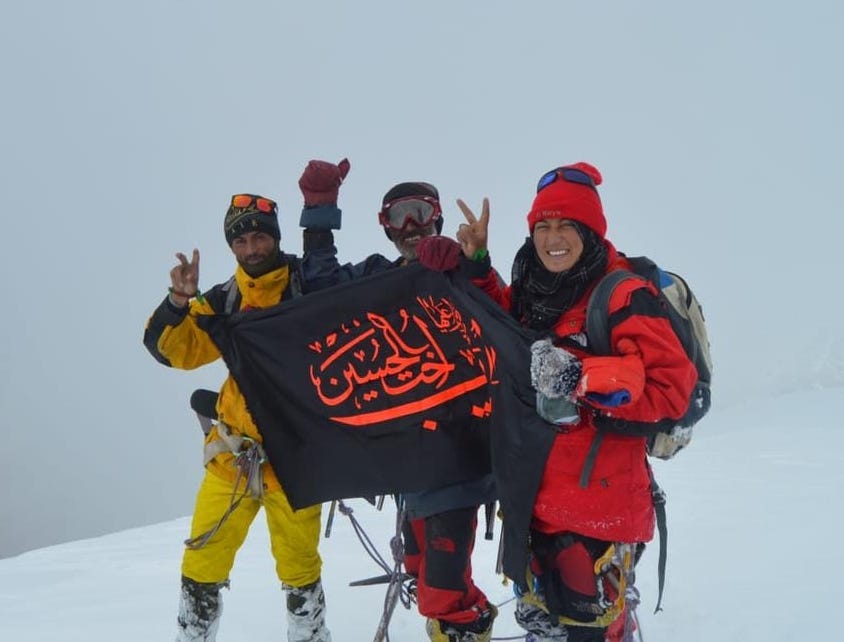
PAKISTANI WOMEN CLIMBERS made news again in 2022 when both Naila Kiani and Samina Baig summited K2. Baig succeeded on her third attempt. About three hours later, Kiani reached the top. Three weeks after K2, Kiani stood on 8080-meter Gasherbrum I. She is now the first Pakistani woman to climb three of Pakistan’s five peaks above 8000 meters.
Amina Shigri wanted to climb Spantik in 2022 but was unable to find financing. She called me recently and expressed her disappointment. “I am poor, and I can’t speak English. I am a simple girl from a small village that no one takes seriously,” Shigri told me.
But threats from the resurgent Tahreek-e-Taliban Pakistan, as well as the traditional patriarchy that continues to prevail over Pakistani society, pose additional challenges for women ahead. Although more women are scaling high mountains, many people in Pakistan even now question the propriety of their going on expeditions guided by non-mahram men (men not in their immediate family).
Within a span of a few years, Pakistani women have shown they can go up some of the world’s most formidable mountains, and they feel encouraged by the response from the media and the public. In Shimshal, a local mountaineer is training women to be mountain guides, but I was unable to find information about whether they will receive any kind of licenses. In years to come girls in Pakistan might read about women from their country who successfully reach the heights of mountains and dream that they, too, will stand atop a mountain and marvel at their accomplishment and the panorama of peaks around them.
[This story originally appeared in Alpinist 81, which is available in our online store.–Ed.]